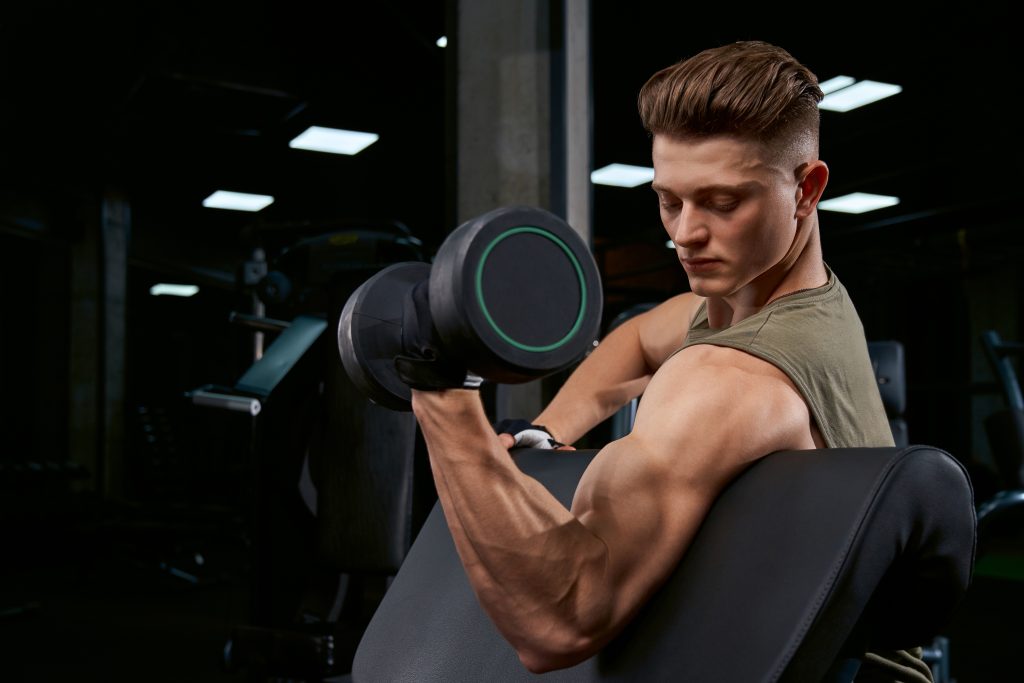The biceps are one of the most prominent muscle groups in the human body. They are responsible for flexing the elbow joint and play a significant role in many other movements. As such, building strong and well-defined biceps is a common goal for many people who engage in strength training. This guide will explore the best ways to grow your biceps, including understanding the anatomy of the biceps, tips for maximizing bicep growth, exercises for bicep growth, developing a bicep workout routine, recovery, and injury prevention.
Contents
Understanding The Anatomy Of The Biceps
Before diving into the best ways to grow your biceps, it’s important to understand the anatomy of the biceps. The biceps brachii is a two-headed muscle that runs from the shoulder to the elbow. The long head of the biceps originates from the supraglenoid tubercle of the scapula, while the short head originates from the coracoid process of the scapula. The two heads of the biceps join together to form a single muscle belly, which inserts into the radius bone at the elbow joint.
The biceps play an important role in many movements, including lifting, pulling, and even rotation of the forearm. When building bicep strength and size, it’s important to understand that different exercises target different parts of the muscle. For example, chin-ups and pull-ups target the long head of the biceps, while bicep curls target the short head.
Tips For Maximizing Bicep Growth
To maximize bicep growth, it’s important to follow a few key principles. One of the most important of these is progressive overload. This simply means that you need to gradually increase the amount of weight you are lifting to continue stimulating muscle growth. Over time, your muscles will adapt to the stress you place on them, so you must continually increase the weight to keep pushing your muscles to grow.
Another important principle for maximizing bicep growth is proper form. When performing bicep exercises, it’s important to maintain good form throughout the movement. This means keeping your back straight, your elbows close to your body, and avoiding swinging or jerking the weight. Proper form ensures that you are targeting the right muscles and avoiding injury.
Finally, proper nutrition is also key to maximizing bicep growth. Your body needs adequate protein to build muscle, so ensure you get enough protein in your diet. Aim for around 0.8-1 gram of protein per pound of body weight daily. In addition, make sure you are getting enough calories to support muscle growth.
Exercises For Bicep Growth
Now that you understand the anatomy of the biceps and the principles for maximizing bicep growth, let’s explore some of the best exercises for bicep growth.
Barbell curls
- Barbell curls are a classic bicep exercise that targets the short head of the biceps. To perform barbell curls, stand with your feet shoulder-width apart and hold a barbell with an underhand grip. Your hands should be shoulder-width apart. Curl the bar up to your chest, keeping your elbows close to your body. Lower the weight back down and repeat for 3-4 sets of 8-12 reps.
Dumbbell curls
- Dumbbell curls are another classic bicep exercise that targets the short head of the biceps. To perform dumbbell curls, stand with your feet shoulder-width apart and hold a dumbbell in each hand. Your palms should be facing forward. Curl the weights up to your chest, keeping your elbows close to your body. Lower the weights back down and repeat for 3-4 sets of 8-12 reps.
Hammer curls
- Hammer curls are a great exercise for targeting the brachialis muscle, which is located beneath the biceps. To perform hammer curls, stand with your feet shoulder-width apart and hold a dumbbell in each hand. Your palms should be facing each other. Curl the weights up to your chest, keeping your elbows close to your body. Lower the weights back down and repeat for 3-4 sets of 8-12 reps.
Chin-ups and pull-ups
- Chin-ups and pull-ups are great exercises for targeting the long head of the biceps. To perform chin-ups, grab a pull-up bar with an underhand grip and pull your body up until your chin is above the bar. To perform pull-ups, grab the bar with an overhand grip and pull your body up until your chest touches the bar. Aim for 3-4 sets of as many reps as possible.
Preacher curls
- Preacher curls are a great isolation exercise for targeting the biceps. To perform preacher curls, sit at a preacher bench and place your upper arms on the padded support. Hold a barbell with an underhand grip and curl the weight to your chest. Lower the weight back down and repeat for 3-4 sets of 8-12 reps.
Developing A Bicep Workout Routine
Now that you’ve explored some of the best exercises for bicep growth, let’s look at how to develop a bicep workout routine. It’s important to remember that your biceps are just one muscle group, so you should incorporate bicep exercises into a larger strength training routine.
A good bicep workout routine should include a mix of compound exercises (such as chin-ups and pull-ups) and isolation exercises (such as bicep curls and preacher curls). You should aim to perform bicep exercises 2-3 times per week, with at least one day of rest in between.
Here is an example bicep workout routine:
- Chin-ups – 3 sets of as many reps as possible
- Barbell curls – 3-4 sets of 8-12 reps
- Hammer curls – 3-4 sets of 8-12 reps
- Preacher curls – 3-4 sets of 8-12 reps
Recovery And Injury Prevention
To maximize bicep growth, allowing your muscles time to recover between workouts is important. This means getting enough sleep, eating a healthy diet, and avoiding overtraining. Overtraining can lead to injuries and slow muscle growth, so make sure you give your muscles enough time to recover.
In addition, paying attention to any pain or discomfort you may be experiencing during bicep exercises is important. If you feel any sharp or shooting pain, stop the exercise immediately and seek medical attention if necessary. Common bicep injuries include strains, tears, and tendonitis.
To prevent bicep injuries, ensure you use proper form during exercises, avoid lifting too much weight, and warm up properly before workouts. You can also incorporate stretches and mobility exercises to improve flexibility and prevent injury.
Use This Guide To Grow Your Biceps Today!
Building strong and well-defined biceps is a common goal for many people who engage in strength training. By understanding the anatomy of the biceps, following key principles for maximizing bicep growth, performing the right exercises, developing a bicep workout routine, and focusing on recovery and injury prevention, you can achieve your bicep goals and build a stronger, more powerful upper body. Remember to always prioritize safety and proper form, and don’t be afraid to seek out the guidance of a qualified trainer







